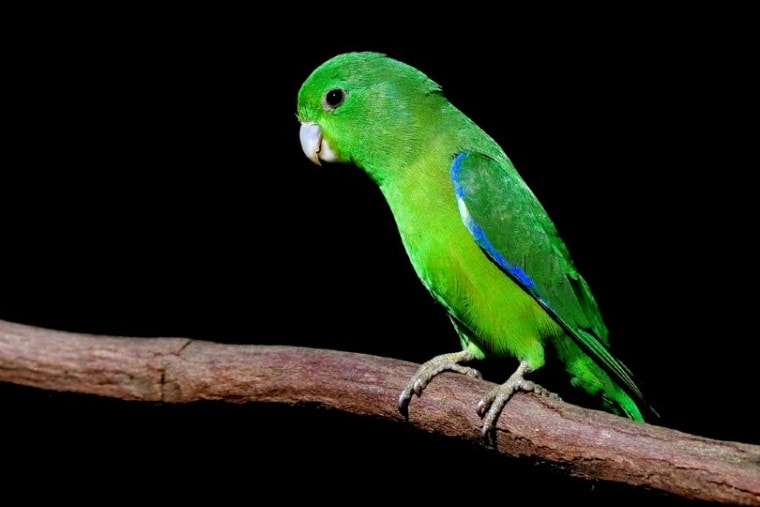
Large parrots have a reputation for having bold, ornery personalities—whereas smaller species are a little more docile. When you look at a parrotlet, you might first assume that they are calm like many of their similar-sized cousins.
You couldn’t be more wrong! These little spitfires will keep you on your toes with lots of melodrama and fire. But, even though they might display amusing antics, they make up for it with warm cuddles. So, let’s see if this parrot species sounds like a good fit for your home.
Quick Facts about Parrotlet Bird
| Common Names: | Parrotlet, pocket parrot |
| Scientific Name: | Forpus coelestis |
| Adult Size: | 5 inches |
| Life Expectancy: | 15 to 20 years |
| Color Form: | Green, blue |
| Enclosure Size: | 18 by 18 inches |
| Diet: | Herbivore |
| Care Level: | Intermediate |
Origin and History
The compact parrotlet naturally lives in the wild, fluttering across tropical scenery in Mexico, Central, and South America. They enjoy lush, sultry forests for both nutrition and protection from predators.
You know what they say about birds of a feather—and these parrots are no exception. Parrotlets form large flocks of up to 100 birds or more. These creatures are highly social, forming intense bonds with mates and family members.
For housing, pocket parrots make nests high up in tree hollows to ward off potential threats and keep the flock safe. The green coloration of their feathers also provides a genius camouflage to hide in plain sight among the foliage.
Parrotlets entered the bird trade industry for their size and appearance. Soon after, they gained popularity among aviarists and private owners. Today, you can find them in most pet shops, online, and from a broad selection of breeders just about anywhere on the map.
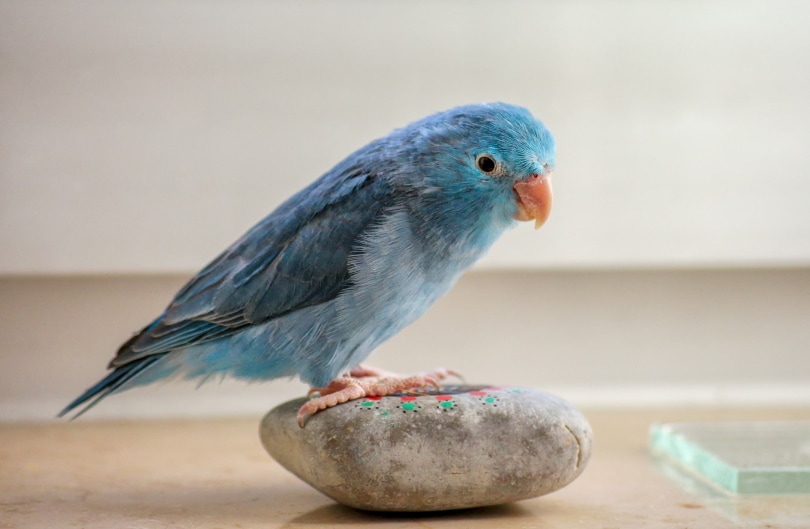
Temperament
Parrotlets are spicy little buggers with charm and attitude. You won’t want to get on their bad side—because they won’t have a problem telling you about it. These birds are forward, quick, and stubborn.
But even though they may have some traits passed down from their big parrot ancestors, these guys are pretty quiet. They don’t use a ton of vocalizations, but they are capable of learning a limited vocabulary.
They can make incredibly close connections with humans, but they will assuredly gravitate toward a favorite. Their natural instinct is to mate and bond—so they may try to do just that with you.
Once they have decided you’re their person, they will shower you with affection. Even when they do something rotten, they turn around to win you over, giving you those big doe eyes. You won’t be able to stay mad long.
However, if you opt for more than one parrotlet (which they would love), you do risk them avoiding you and turning to their bird friends for companionship. Some might even display annoyance or aggression if you try to interfere once a bond is in place.
However, that doesn’t happen in every case. Each parrotlet will have its own quirks, individual to that animal.
Speech & Vocalizations
If you want a parrot that mimics little choice phrases, having a parrotlet isn’t really the best choice. Even though they can formulate certain sounds, speech isn’t their strong suit.
They can learn a limited range of words in comparison to other parrot species. For example, African Grey parrots know up to 1,000 words, whereas parrotlets fall somewhere around the 300-word threshold.
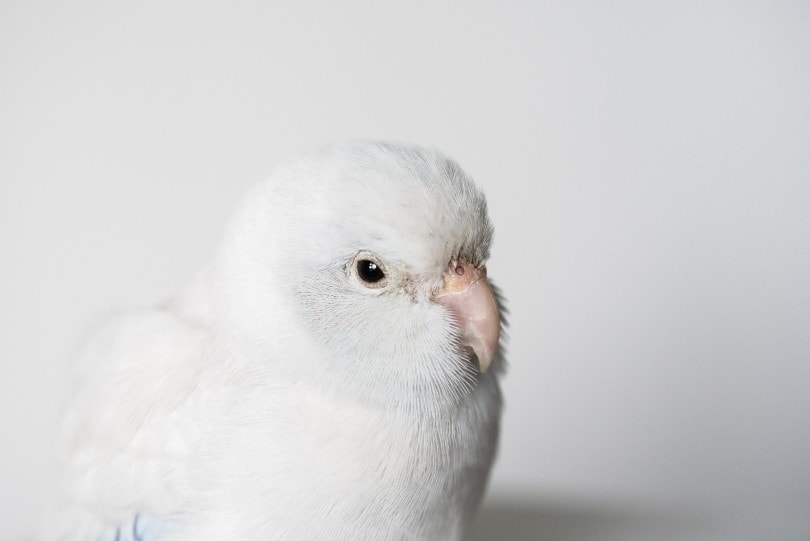
Parrotlet Colors and Markings
There is quite a selection of choices when it comes to color and markings. Even though all parrotlets are primarily green, certain types present different looks, setting them apart from the rest.
Not all parrotlets will be easy to find on the market, as some of these species are rare. But it’s fun to admire just how many appearances one species can take on.
Caring for the Parrotlet
Grooming is a significant part of parrotlet care because their needs are so unique. Like all birds, they don’t have a problem taking their own bathes, but you still need to help out in other areas.
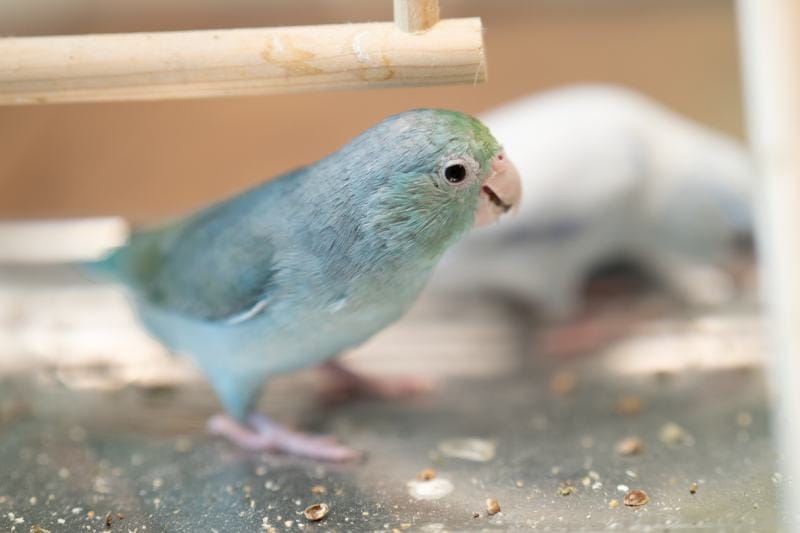
Bathing
The good news is, when it comes to bathing, you don’t really have to lift a finger. Your parrotlet will go gaga over a lukewarm bath, dunking, fluttering, and preening in the water.
All you have to do is find a suitable shallow container that your bird can’t tip over. Fill it up with a little lukewarm room temperature water, and then let them do their thing. Some parrotlets will take longer baths than others.
Flight Feather Trimming
One unfortunate aspect to parrotlet owning is that they have to have their flight feathers trimmed—no ifs, ands, or buts. Birds continually regrow flight wings, so you need a professional to keep them at a necessary length.
Untrimmed feathers can equal unwanted escapes and injuries. Trying to keep up with this little grooming aspect, you should make sure flight feathers get a trim at least every three months.
Nail Clipping
Most parrotlets trim their own nails, but there are exceptions. Sometimes, the nail will overgrow a bit, which needs tending. You can perform nail-trimming on an as-needed basis.
If you feel uncomfortable doing this at home, you can always rely on professionals to do the dirty work for you. It’s always best to leave it in your vet’s hands if you feel uncertain.
Common Health Problems
Just like any other pet, your parrotlet might run into occasional health issues. That’s why it’s so important to secure an exotic vet in your area that specializes in tropical bird care.
The trouble with birds of so many kinds is that they tend to show late-stage symptoms. So, it can be really hard to tell if your bird is sick—and sometimes too late when you finally do.
Don’t let this concern you too much. Just keep your parrotlet healthy and watch for any behavioral changes that might raise a red flag. Since it can be tricky, here are some visual cues you might want to keep an eye out for.
Diet and Nutrition
The parrotlet has a similar diet to many parrots its size. They need a pretty solid balance of raw plant matter, pellets, and seeds for optimal health. These birds won’t typically overeat on their regular meals but avoid too many treats.
Exercise
Even though they are small, don’t let that fool you about their exercise needs. Parrotlets need some time out of their enclosure every day to explore.
Here are some ways to entertain your parrotlet:
You should always monitor your parrotlet when they free range. Make sure fans are turned off, windows are shut, and doors are secure. These guys are little, and they can get hurt easily.
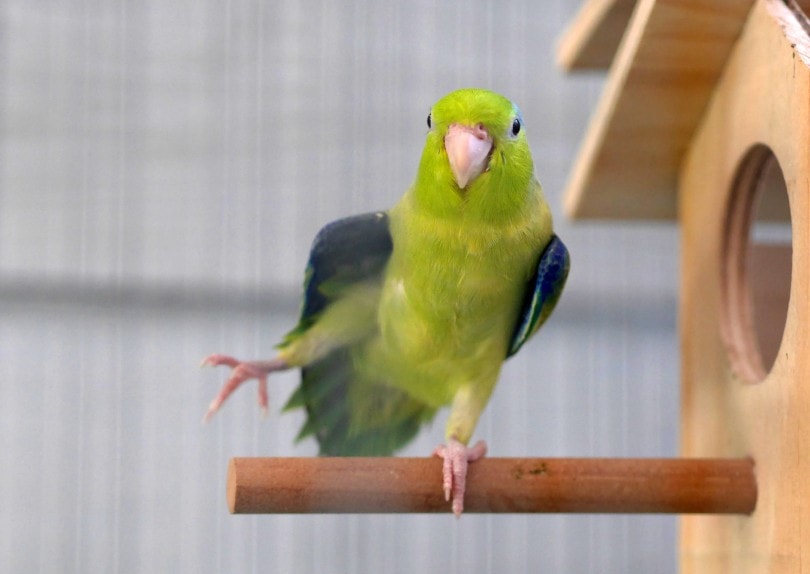
Where to Adopt or Buy a Parrotlet
Since parrotlets are a widespread bird in the trade, parrotlets can be found just about anywhere. Here are some options to keep in mind:
Final Thoughts
So, does an adorable pocket parrot sound like something you want to bring home? These pets live longer than parakeets and cockatiels—plus, they come with the personality of a larger parrot.
Granted, these parrots won’t work for all personality types or home situations—and they might not work as well for beginners. But they can bring enrichment to the right owner.
Featured Image Credit: KAROLINEZAMLUTI, Shutterstock











